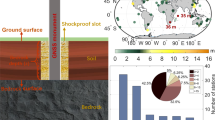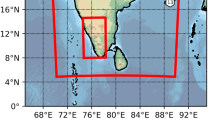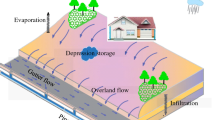Abstract
Nevado del Huila, a glacier-covered volcano in the South of Colombia’s Cordillera Central, had not experienced any historical eruptions before 2007. In 2007 and 2008, the volcano erupted with phreatic and phreatomagmatic events which produced lahars with flow volumes of up to about 300 million m3 causing severe damage to infrastructure and loss of lives. The magnitude of these lahars and the prevailing potential for similar or even larger events, poses significant hazards to local people and makes appropriate modeling a real challenge. In this study, we analyze the recent lahars to better understand the main processes and then model possible scenarios for future events. We used lahar inundation depths, travel duration, and flow deposits to constrain the dimensions of the 2007 event and applied LAHARZ and FLO-2D for lahar modeling. Measured hydrographs, geophone seismic sensor data and calculated peak discharges served as input data for the reconstruction of flow hydrographs and for calibration of the models. For model validation, results were compared with field data collected along the Páez and Simbola Rivers. Based on the results of the 2007 lahar simulation, we modeled lahar scenarios with volumes between 300 million and 1 billion m3. The approach presented here represents a feasible solution for modeling high-magnitude flows like lahars and allows an assessment of potential future events and related consequences for population centers downstream of Nevado del Huila.











Similar content being viewed by others
References
Arattano M (1999) Monitoring the propagation of a debris flow along a torrent. Hydrol Sci 44(5):811–823
Ávila G, Caro P, Cepeda H, Moreno M, Torres P, Agudelo A (1995) Zonificación para uso del suelo en la cuenca del río Páez. Jornadas geotécnicas. Soc Ingen Soc Colomb Geotech 8:78–102
Baker VR (2000) Palaeoflood hydrology and the estimation of extreme floods. In: Wohl EE (ed) Inland flood hazards: human, riparian and aquatic communities. Cambridge University Press, Cambridge, pp 359–377
Berti M, Simoni A (2007) Prediction of debris flow inundation areas using empirical mobility relationships. Geomorphology 90:144–161
Calderón Y, Ávila G, Ojeda J (1997) Estudio de amenazas y zonificación geologica de la cuenta del Rio Páez, Cauca. 2nd Pan-Am Symp Landslides, 2nd COBRAE. Rio de Janeiro
Canuti P, Casagli N, Catani F, Falorni G (2002) Modeling of the Guagua Pichincha volcano (Ecuador) lahars. Phys Chem Earth 27:1587–1599
Capra L (2007) Volcanic natural dams: identification, stability and secondary effects. Nat Hazard 43:45–61
Capra L, Poblete MA, Alvarado R (2004) The 1997 and 2001 lahars of Popocatépetl volcano (Central Mexico): textural and sedimentological constraints on their origin and hazards. J Volcanol Geotherm Res 131:351–369
Carrasco-Núñez G, Díaz-Castellón R, Siebert L, Hubbard B, Sheridan MF, Rodríguez SR (2006) Multiple edifice-collapse events in the Eastern Mexican Volcanic Belt: The role of sloping substrate and implications for hazard assessment. J Volcanol Geotherm Res 158(1–2):151–176
Carrivick JL (2006) Application of 2D hydrodynamic modelling to high-magnitude outburst floods: an example from Kverkfjöll, Iceland. J Hydrol 321:187–199
Carrivick JL, Manville V, Cronin SJ (2009) A fluid dynamics approach to modelling the 18th March 2007 lahar at Mt. Ruapehu, New Zealand. B Volcanol 71:153–169
Cenderelli DA, Wohl EE (2003) Flow hydraulics and geomorphic effects of glacial-lake outburst floods in the Mount Everest region, Nepal. Earth Surf Proc Land 28:385–407
Coussot P (1997) Mudflow rheology and dynamics. IAHR monograph series. A.A. Balkema, Rotterdam, p 255
Davila N, Capra L, Gavilanes-Ruiz JC, Varley N, Norini G (2007) Recent lahars at Volcán de Colima (Mexico): drainage variation and spectral classification. J Volcanol Geotherm Res 165:127–141
FLO-2D Software I (2009) FLO-2D User's Manual. Available at: www.flo-2d.com
Hubbard BE, Sheridan MF, Carrasco-Núñez G, Díaz-Castellón R, Raúl Rodríguez S (2007) Comparative lahar hazard mapping at Volcan Citlaltépetl, Mexico using SRTM, ASTER and DTED-1 digital topographic data. J Volcanol Geotherm Res 160(1–2):99–124
Huggel C, Ceballos JL, Pugarín B, Ramírez J, Thouret J-C (2007) Review and reassessment of hazards owing to volcano-glacier interactions in Colombia. Ann Glaciol 45:128–136
Huggel C, Schneider D, Miranda PJ, Delgado Granados H, Kääb A (2008) Evaluation of ASTER and SRTM DEM data for lahar modeling: a case study on lahars from Popocatépetl Volcano, Mexico. J Volcanol Geotherm Res 170(1–2):99–110
Iverson RM, Vallance JM (2001) New views of granular mass flows. Geology 29(2):115–118
Iverson RM, Schilling SP, Vallance JW (1998) Objective delineation of lahar-inundation hazard zones. Geol Soc Am Bull 110(8):972–984
Jakob M, Hungr O (2005) Debris flow hazards and related phenomena. Springer, Berlin
Jakob M, Hungr O, Pierson TC (2005) Hyperconcentrated flow—transitional process between water flow and debris flow. In: Debris flow hazards and related phenomena. Springer, Berlin, pp. 159–202
Lavigne F, Thouret JC (2002) Sediment transportation and deposition by rain-triggered lahars at Merapi Volcano, Central Java, Indonesia. Geomorphology 49:45–69
Lavigne F, Thouret J-C, Voight B, Young K, La Husen R, Marso J, Suwa H, Sumaryono A, Sayudi DS, Dejean M (2000) Instrumental lahar monitoring at Merapi Volcano, Central Java, Indonesia. J Volcanol Geotherm Res 100:457–478
Major JJ, Newhall CG (1989) Snow and Ice perturbation during historical volcanic eruptions and the formation of lahars and floods. B Volcanol 52:1–27
Martínez JM, Ávila G, Agudelo A, Schuster RL, Casadevall TJ, Scott KM (1995) Landslides and debris flows triggered by the 6 june 1994 Páez earhquake, southwestern Colombia. Landslide News 9:13–15
Muñoz-Salinas E, Manea VC, Palacios D, Castillo-Rodriguez M (2007) Estimation of lahar flow velocity on Popocatépetl volcano (Mexico). Geomorphology 92(1–2):91–99
O'Brien JS (2003) Reasonable assumptions in routing a dam break mudflow. In: Rickenmann D, Chen CL (eds) Debris-flows hazard mitigation: mechanics, prediction, and assessment. Millpress, Rotterdam, pp 683–693
O'Brien JS, Julien PY (1988) Laboratory analysis of mudflow properties. J Hydraul Eng ASCE 119(2):244–259
O'Brien JS, Julien PY, Fullerton WT (1993) Two-dimensional water flood and mudflow simulation. J Hydraul Eng ASCE 119(2):244–261
Pierson TC (1998) An empirical method for estimating travel times for wet volcanic mass flows. B Volcanol 60:98–109
Pierosn TC, Scott KM (1985) Downstream dilution of a lahar: transition from debris flow to hyperconcentrated streamflow. Water Resour Res 21(10):1511–1524
Pierson TC, Janda RJ, Thouret J-C, Borrero CA (1990) Perturbation and melting of snow and ice by the 13 November 1985 eruption of Nevado del Ruiz, Colombia, and consequent mobilization, flow and deposition of lahars. J Volcanol Geotherm Res 41:17–66
Pulgarín B, Cardona C, Calvache M, Lockhart A, White R (2007) Huila lahars caused by rapid, voluminous water expulsion. In: Abstract volume cities on volcanoes 5 conference, Shimabara, Japan, p 113
Pulgarín B, Jordan E, Linder W (1996) Nevado del Huila (Colombia): Cambio glaciar entre 1961 y 1995. In: Proceedings VII Congreso Colombiano de Geología. Tome I, Ingeominas, Santafé de Bogotá, pp 440–451
Pulgarín B, Macías JL, Cepeda H, Capra L (2004) Late pleistocene deposits associated with a southern flank collapse of the Nevado del Huila volcanic complex (Colombia). Acta Volcanol 16(1–2):37–58
Rabus B, Eineder M, Roth A, Bamler R (2003) The shuttle radar topography mission—a new class of digital elevation models acquired by spaceborn radar. ISPRS J Photogramm 57:241–262
Schatzmann M (2005) Rheometry for large particle fluids and debris flows. Dissertation, ETH Zurich, Switzerland
Scott KM, Macías JL, Naranjo JA, Rodriguez S, McGeehin JP (2001) Catastrophic debris flows transformed from landslides in volcanic terrains: mobility, hazard assessment, and mitigation strategies. U.S. Geological Survey Professional Paper 1630
Smith GA, Lowe DR (1991) Lahars: volcano-hydrologic events and deposition in the debris flow—hyperconcentrated flow continuum. In: Smith GA, Fisher RV (eds) Sedimentation in volcanic settings. SEPM (Society for Sedimentary Geology), Tulsa, pp 59–70
Stevens NF, Manville V, Heron DW (2002) The sensitivity of a volcanic flow model to digital elevation model accuracy: experiments with digitised map contours and interferometric SAR at Ruapehu and Taranaki volcanoes, New Zealand. J Volcanol Geotherm Res 119:89–105
Stolz A, Huggel C (2008) Debris flows in the Swiss National Park: the influence of different flow models and varying DEM grid size on modeling results. Landslides 5:311–319
Thouret J-C (1990) Effects of the November 13, 1985 eruption on the snow pack and ice cap of Nevado del Ruiz volcano, Colombia. J Volcanol Geotherm Res 41:177–201
USGS (2011) Verified roughness characteristics of natural channels. Available at: http://wwwrcamnl.wr.usgs.gov/sws/fieldmethods/Indirects/nvalues/index.htm. Accessed 10 March 2011
Van Westen CJ, Daag AS (2005) Analysing the relation between rainfall characteristics and lahar activity at Mount Pinatubo, Philippines. Earth Surf Proc Land 30(13):1663–1674
Vignaux M, Weir GJ (1990) A general model for Mt. Ruapehu lahars. B Volcanol 52(5):381–390
Weir GJ (1982) Kinematic wave theory for Ruapehu lahars. N Z J Sci 25(3):197–203
Acknowledgments
We would like to thank Adriana Agudelo and Martha Calvache for inviting us to Colombia and for working with INGEOMINAS. Special thanks are addressed to all other persons from INGEOMINAS who supported us in different ways within the present study. For the calibration of LAHARZ, we appreciate advice from Steve Schilling from USGS. We are very grateful for his collaboration and his inputs. USGS also provided satellite images for this work, which were very useful for glacier investigations. The study has been supported financially by the Swiss Agency for Development and Cooperation. We appreciate the constructive reviews of Thomas Pierson, Lucia Capra, the associate editor Hugo Delgado and the executive editor James White.
Author information
Authors and Affiliations
Corresponding author
Additional information
Editorial responsibility: H. Delgado Granados
Rights and permissions
About this article
Cite this article
Worni, R., Huggel, C., Stoffel, M. et al. Challenges of modeling current very large lahars at Nevado del Huila Volcano, Colombia. Bull Volcanol 74, 309–324 (2012). https://doi.org/10.1007/s00445-011-0522-8
Received:
Accepted:
Published:
Issue Date:
DOI: https://doi.org/10.1007/s00445-011-0522-8




